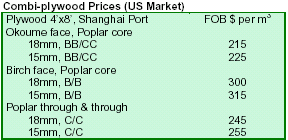|
US
Dollar Exchange Rates of 8th May
2006
China Yuan
8.007
Report from China
China imports more timber products except panels
According to China Customs, China¡¯s timber imports continued to grow in the first quarter in 2006, except
wood-based panel imports which declined markedly. In the period under review, log imports surged to 8.1
million m3 valued at $897.42 million, up 18% and 19%, respectively from the same period in 2005. Of the total
log imports, softwood logs mostly from Russia accounted for 64%, up 26% from the first quarter in 2005.
Sawnwood imports amounted to 1.45 million m3 worth $385.72 million, up 7% and 20% respectively from the
same period in 2005. Imports of veneer reached 29,500 tons valued at $9.1 million, up 11%. In contrast, plywood
imports declined to 105,000 m3 worth $44.21 million, down 47% and 56% respectively. The imports of
fiberboard also eased to 141,400 tons valued at $46.2 million, down 9% and 12% respectively.
Chinese exports of sawnwood and wood-based panels rose in the first quarter in 2006.
Sawnwood exports surged to 201,400 m3 valued at US$72.37 million, up 58% and 28% respectively from the same period in 2005.Plywood exports also increased to 1.275 million m3
worth $442.49 million, up 23% and 30%. Exports of fiberboard rose to 245,800 tons valued at $109.74
million, up 40% and 64% respectively from the same period in 2005.
Fiberboard sector expands production capacity
In 2005, 56 new fiberboard production lines with a production capacity of 3.35 million m3 came into
operation in mainland China, bringing the national total capacity to 22.61 million m3. It is predicted that the
growth of the fiberboard industry will slow in 2006 and reach an annual production capacity close to 24.4 million
m3. China¡¯s fiberboard production lines were distributed in 15 provinces in 2005. The top 5 provinces in added
production capacity were Shandong, Anhui, Jiangsu, Sichuan and Hubei. The top 10 provinces in fiberboard
production capacity had 389 production lines with an annual production capacity of 18.14 million m3,
accounting for 80% of the national total. Shandong province ranked first in terms of production line (115)
and production capacity (4.75 million m3).
Paper multinationals bet on China¡¯s market
Several paper multinationals, such as Singapore RGM International, Finnish Stora Enso, Kimberly-Clark and
UPM-Kymmene, have invested heavily in China¡¯s paper industry. According to local experts, the total output of
China¡¯s paper and paperboard is projected at nearly 80 million tonnes by 2010. These multinationals are
competing fiercely for the Chinese market. Currently, several firms are conducting market research on the
Chinese paper market so as to define their overall strategy in the country.
China calls off plan for ¡°green¡± GDP index
China has called off plans for a ¡°green measure¡± on GDP. The National Bureau of Statistics (NBS) said the
plan to introduce a new measure of national economic output that took into account the impact on the
environment had been dropped because of problems in calculating such a figure. In 2003, the government
commissioned the NBS to draw up a ¡°green GDP¡± index for use in benchmarking the performance of local
officials, now currently assessed mainly on the speed of economic growth in their localities. Worried that officials
have pursued growth at all costs, the government¡¯s 2006-2010 five year economic plan calls for a more
balanced development model.
The debate over the proposed ¡°green GDP¡± index has set the NBS against the State
Environment Protection Agency (Sepa), which continues to back the idea. NBS
says that Sepa had trouble appreciating the problems in producing a single, simple figure which reflected all the
complexities of measuring environmental impact. The NBS is instead working on the
introduction of so-called ¡°green accounting¡± in China, a system backed by the UN
which tracks resources such as water, raw materials and tracks resources such as water, raw materials and
grass lands. Norway¡¯s statistics bureau has just funded a year-long study with the NBS on ¡°green accounting¡±.


Birch- and poplar-poplar ply have low yield rate due to small diameter and bad quality,
and are therefore more expensive than okoume-poplar ply.
¡¡
|